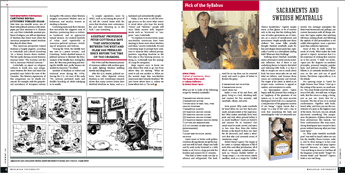Unsympathetic Portrayals
 Next time you stumble across one of those witty political cartoons in the newspaper, pay close attention to it. Chances are, says Peter Gottschalk, assistant professor of religion, you will see depictions of Muslims that reveal more about the American perspective toward Muslims than they do about Islam.
Next time you stumble across one of those witty political cartoons in the newspaper, pay close attention to it. Chances are, says Peter Gottschalk, assistant professor of religion, you will see depictions of Muslims that reveal more about the American perspective toward Muslims than they do about Islam.
This American perspective toward Muslims is largely negative, according to Gottschalk and Gabriel Greenberg ’04, a history honors thesis student. The two spoke during a recent Reunion seminar titled, “The Scimitar and the Veil in American Political Cartoons.”
Gottschalk, an expert on religious cultures in South Asia, says antagonism between the West and Islam has prevailed since before the time of the Crusades. The Western expressions of this antagonism can be clearly witnessed, for example, with the geopolitical ascendancy of European nations during the 19th century, when Western imagery caricatured Muslim men as barbarians and Muslim women as residing in harems.
Greenberg examined three themes that exacerbate the negative view of Muslims: portraying them as violent, as backward, and as oppressive toward women. He studied symbols of Islam used repetitively in American political cartoons, including oil, weaponry, and violence.
“During the 1950s, the Middle East was seen as a power vacuum,” said Greenberg. “Artists sketched women in political cartoons to illustrate the feminization of the Middle East. During this time, the West was protecting and wooing the Middle East, partly because we needed its resources,” he added.
Symbols of Muslims as violent and irrational arose during the 1970s. During the U.S. oil crisis of the early ’70s, cartoons portrayed Arabs and sheikhs hoarding oil, while indulging in its wealth.
“A simple capitalistic move by OPEC, such as increasing the price of oil, left the United States with the sense that Muslims were untrustworthy and were ?shooting us in the back.’” says Greenberg.
The 1990s Gulf War featured cartoons of American soldiers with machine guns on tanks fighting Muslims wielding swords and riding horses.
After the 9/11 attacks, political cartoons have often depicted certain Muslims as evil. Greenberg’s research shows that many cartoon artists have sketched Muslims as Satan, and as a backward and untrustworthy people.
Today, if you were to ask the average person on the street what comes to mind when s/he hear the words “Islam” and “Muslim,” people will most likely answer with negative words such as “terrorists” or “suspects,” says Gottschalk.
“In response to recent events, many non-Muslim Americans have been wanting to know more about Muslims and Islam,” asserts Gottschalk. He and Greenberg hope to prompt their audience to examine their cultural presuppositions regarding Muslims as the first step in this learning process. In doing so, Gottschalk uses the analogy of a map for navigation.
Maps require users to know not only where they wish to go, but from where they are starting. “What we need to ask one another is, What are the mental maps that non-Muslim Americans have towards Muslims? We can’t know where there is, unless we know where here is,” he said.
